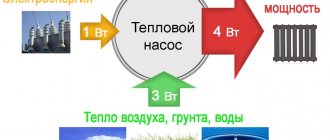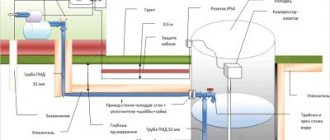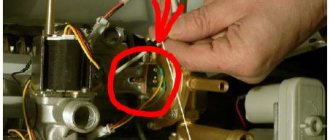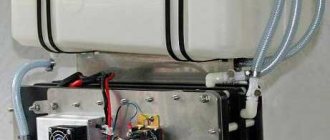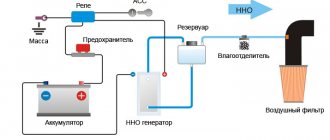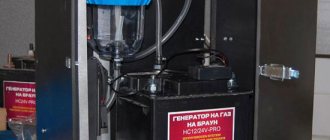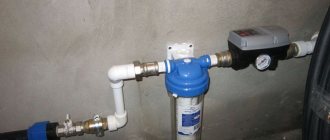Water disinfection by direct electrolysis
What is direct electrolysis of water?
The passage of electric current through the treated water is accompanied by a series of electrochemical reactions, as a result of which new substances are formed in the water and the structure of intermolecular interactions changes. During direct electrolysis of water, the synthesis of oxidizing agents occurs - oxygen, ozone, hydrogen peroxide, etc. In addition, in water even with a very low chloride content, during direct electrolysis, residual chlorine is formed, which is very important for the prolonged effect of water disinfection.
Theory of the water electrolysis process
In a simplified form, direct electrolysis of water consists of several processes.
1) Electrochemical process.
In water (H2O), two plates (electrodes) are located in parallel: the anode and the cathode. DC voltage applied to the electrodes causes electrolysis of water.
Oxygen is produced at the anode : 2H2O → O2 + 4H+ + 4e− (water is acidified).
Hydrogen is formed at the cathode: 2H2O + 2e− → H2 + 2OH− (water becomes alkaline).
The amount of hydrogen released is small and not a big problem.
The use of special electrodes allows the production of ozone and hydrogen peroxide from water.
Ozone is produced at the anode : 3H2O → O3 + 6e− + 6H+ (water is acidified).
At the cathode - hydrogen peroxide : O2 + 2H2O + 2e− → H2O2 + 2OH− (water is alkalized).
Natural fresh (not distilled) water always contains mineral salts - sulfates, carbonates, chlorides. In order to obtain chlorine for a prolonged effect of water disinfection, only chlorides are of interest. In water they are mainly sodium chloride (NaCl), calcium chloride (CaCl) and potassium chloride (KCl).
Using the example of sodium chloride, the reaction for the formation of chlorine by electrolysis will be as follows.
Salt dissolved in water: 2NaCl + H2O → 2Na+ +2Cl– + 2H2O
During electrolysis, chlorine is formed at the anode: 2Cl– → Cl 2 +2e– (water is acidified).
And sodium hydroxide is formed at the cathode: Na+ + OH– → NaOH (water becomes alkaline).
This reaction is short-lived because any chlorine produced at the anode is quickly consumed to form sodium hypochlorite : Cl2 + 2NaOH → H2 + 2 NaOCl .
Similar electrolysis reactions occur with calcium and potassium chlorides.
Thus, as a result of the electrolysis of fresh water, a mixture of strong oxidizing agents is generated: oxygen + ozone + hydrogen peroxide + sodium hypochlorite .
2) Electromagnetic process.
A water molecule is a small dipole containing positive (hydrogen side) and negative (oxygen side) charges at the poles. In an electromagnetic field, the hydrogen part of the water molecule is attracted to the cathode, and the oxygen part to the anode. This leads to weakening and even breaking of hydrogen bonds in the water molecule. The weakening of hydrogen bonds promotes the formation of atomic oxygen. The presence of atomic oxygen in water helps reduce water hardness. Calcium is always present in ordinary water. Ca+ ions are oxidized by atomic oxygen: Ca+ + O → CaO. Calcium oxide, combining with water, forms calcium oxide hydrate: CaO + H2O → Ca(OH)2. Calcium oxide hydrate is a strong base, highly soluble in water. Similar processes occur with other elements of water hardness.
3) Cavitation processes.
As a result of the electrochemical and electromagnetic process, microscopic gas bubbles of oxygen and hydrogen are formed. A whitish cloud consisting of emerging bubbles appears near the surface of the electrodes. Entrained by the flow of water, the bubbles are displaced to an area where the flow velocity is lower and the pressure is higher, and they collapse at high speed.
The instantaneous collapse of the bubble releases enormous energy, which destroys the water wall of the bubble, i.e. water molecules. The consequence of the destruction of a water molecule is the formation of hydrogen and oxygen ions, atomic particles of hydrogen and oxygen, hydrogen and oxygen molecules, hydroxyls and other substances.
The listed processes contribute to the formation of the main oxidizing agent - atomic oxygen.
What is unique about direct electrolysis of water?
Water disinfection by direct electrolysis is a type of oxidative water treatment, but it is fundamentally different from common disinfection methods in that oxidizing agents are produced from the water itself, and are not introduced from the outside and, having fulfilled their function, return to their previous state. The efficiency of water disinfection by direct electrolysis is several times higher compared to chemical methods. Direct electrolysis of water helps remove color, hydrogen sulfide, and ammonium from the source water. Direct electrolysis does not require dosing pumps or reagents.
Chlorine, necessary to prevent secondary bacterial contamination of water in distribution networks, is activated from natural mineral salts in the water passing through the electrolyzer and instantly dissolves in it. Direct electrolysis breaks down chloramines, converting them to nitrogen and salt.
Source
Share on social networks:
We also recommend reading:
Antioxidants. The effect of antioxidants
How to choose a water ionizer?
Alkaline - hydrogen water
Latest blog articles
Alkaline water storage technologies Cleaning the FUJIIRYOKI water ionizer chamber Direct electrolysis - this is important to know! A complete understanding about the plates in water ionizers Is the number of plates in water ionizers important?
Water purification by electrolysis
27.08.2020
The issue of the quality of water flowing from our taps is becoming increasingly relevant with the development of industry in cities. After all, its purity and quality are inextricably linked with our health. On average, a person drinks about 750 liters of water per year, which consists of 70% of it. Water performs many functions in our body: metabolism, removal of accumulated toxins and breakdown products, maintaining thermal balance. Dehydration is more dangerous than not eating enough.
Tap water is at best suitable for bathing and washing dishes. It contains a lot of impurities: rust, heavy metals, chemical impurities, calcium and magnesium salts and a wide variety of substances of the class of carcinogenic chemical compounds. Impurities enter the drinking water reservoir through wastewater, groundwater, and simply from old rusty water pipes. Water purification is the process of removing contaminants from water; in most cases, purification is done to make the water suitable for drinking. In order to demonstrate all the dirt that is contained in tap water and that we drink, it is enough to carry out the process of water purification by electrolysis in one glass of water taken from the tap. It’s an impressive sight—crystal-clear-looking water from the tap becomes cloudy and dirty in a moment, and a layered green-brown sediment is visible to the naked eye, falling in layers to the bottom of the glass. Any observer of the water treatment process will immediately involuntarily think about the health of internal organs, kidney stones, the immune system and much more.
BWT solutions for industrial and domestic water treatment:
Mechanical filters
Activated carbon filter
Removal of iron and manganese
Filters for washing
To get a consultation
Water purification by electrolysis
is a physical and chemical process. It consists in the release of various components of substances dissolved in water on the electrodes. The procedure for purifying water by electrolysis occurs when an electric discharge is passed through a solution or melt of electrolyte. In chemistry, an anode is a positive electrode, and a cathode is a negative electrode. Positive ions - (cations) - begin to move towards the cathode, negative ions - (anions) - tend to the anode. The essence of the process is as follows: in the electric field created by electrodes connected to a source of electrical energy, an ordered movement of ions occurs. For the process to occur, you only need to place the device in a conductive liquid - water. Electrolysis of water is a complex electrolytic process for the purification of tap water, in which, using an electric current, water is broken down into its components - oxygen and hydrogen; sometimes a six-volt battery is used for this process. The electrolysis cell consists of two electrodes. They are connected to opposite poles of a source of electrical energy. The first examples of the use of electrolysis are described in history and dated back to approximately 300 century BC.
Wide application of electrolysis water purification process
due to its effectiveness. The result of such water treatment is the destruction of organic substances in water and the extraction of metals, acids, inorganic substances and impurities. Electrolytic purification is carried out using special devices - electrolyzers. It is worth noting that an ordinary hydraulic pump is a simple device for elementary electrolysis of tap water.
Since water purification by electrolysis is based on the ability of substances to decompose under the influence of electric current, the use of this method has a number of advantages, the main one of which is a high degree of purification, which allows purified water to be transferred to municipal facilities; it should also be noted that substances (CO2, H2, O2 ), formed during the breakdown of water, have a much smaller impact on the environment than those contained in the source water. The disadvantages of this method include increased energy consumption. Today it is of interest to use this method for local purification of reservoirs containing thiocyanate, thiosulfate and sodium sulfate with a high concentration of pollutants. Currently, installations for water purification by electrolysis
are being developed everywhere, research is underway on this promising method, which in the future will eliminate a number of important problems related to human health and environmental protection.
Electrolysis of water. How does the process happen and why is it needed?
Electrolysis is a special physical and chemical process in which a liquid, or, in other words, an electrolyte, breaks down into positive and negative ions. This happens under the influence of electric current. How does this process take place?
Electrolysis of water occurs due to the fact that an electric current passing through the electrolyte causes a reaction at the electrodes, on which positive and negative ions are deposited. Cations are deposited on the negatively charged electrode (cathode), and anions are deposited on the positive (anode). The electrolyte may consist of water to which an acid has been added, or it may be a solution of salts. The decomposition of salts into metal and an acidic residue occurs after an electric current is passed through the electrolyte. A metal charged with positive electricity approaches the cathode (negatively charged electrode), and it is this metal that is called a cation. The acidic residue, negatively charged, tends to the anode (positively charged electrode), and is called an anion. Electrolysis makes it possible to obtain well-purified elements from salts, due to which it is widely used in various branches of modern industry.
Electrolysis of water is vital today, when thousands of enterprises use water for individual stages of their production. This is explained by the fact that after most of the processes that are carried out in enterprises, water after use turns into a liquid dangerous for people and wildlife. Electrolysis of water is used to purify wastewater that should not fall into the ground or into sources of clean water. This wastewater must be treated in order to prevent an environmental disaster, the risk of which is already quite high in many regions of Russia.
Today there are several methods of water electrolysis. These include electroextraction, electrocoagulation and electroflotation. Electrolysis of water used for wastewater treatment is carried out in electrolyzers. These are special structures in which organic substances are decomposed into metals, acids and other substances classified as inorganic. It is especially important to carry out wastewater treatment in hazardous industries, such as chemical industry enterprises, where work is carried out with copper and lead, as well as in factories producing paints, varnishes, and enamels. Of course, this is far from a cheap way to purify water using electrolysis, but the costs associated with water purification cannot be compared with human health and concern for the environment.
An interesting fact, but you can carry out electrolysis of water at home. This process will not take much time and money and will provide the opportunity to produce oxygen and hydrogen. Two electrodes are lowered into a container of water in which salt has been previously dissolved (salt must be taken at least ¼ of the volume of water). They can be made from any metal. The electrodes are connected to a power source with a current of at least 0.5 A. Bubbles form on one of the electrodes, which indicates that water electrolysis at home is successful. This method can produce sodium hydroxide, chlorine and other chemical elements, depending on what the electrolyte consists of. Plasma electrolysis of water is used in plasma heaters. This is the latest modern device that operates in modes of plasma electrolysis of water and its direct heating to certain temperatures. Plasma electrolysis of water makes it possible to obtain new types of energy, which humanity needs more and more every day. The energy that can be obtained from water will provide an opportunity to create new, safe and efficient types of energy sources. The phenomena of plasma electrolysis of water have not yet been fully studied, but they have great prospects and are therefore intensively studied by modern scientists.




